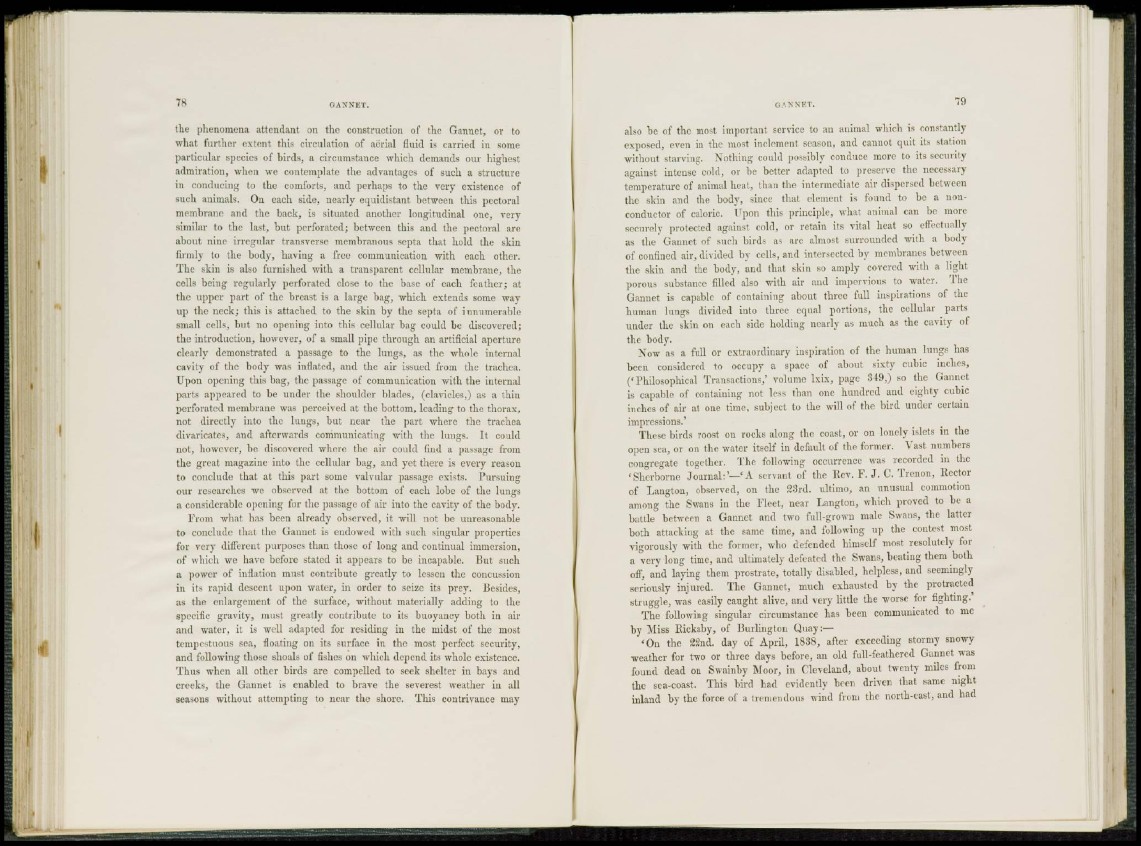
the phenomena attendant on the construction of the Gannet, or to
what further extent this circulation of aerial fluid is carried in some
particular species of birds, a circumstance which demands our highest
admiration, when we contemplate the advantages of such a structure
in conducing to the comforts, and perhaps to the very existence of
such animals. On each side, nearly equidistant between this pectoral
membrane and the back, is situated another longitudinal one, very
similar to the last, but perforated; between this and the pectoral are
about nine irregular transverse membranous septa that hold the skin
firmly to the body, having a free communication with each other.
The skin is also furnished with a transparent cellular membrane, the
cells being regularly perforated close to the base of each feather; at
the upper part of the breast is a large bag, which extends some way
up the neck; this is attached to the skin by the septa of innumerable
small cells, but no opening into this cellular bag could be discovered;
the introduction, however, of a small pipe through an artificial aperture
clearly demonstrated a passage to the lungs, as the whole internal
cavity of the body was inflated, and the air issued from the trachea.
Upon opening this bag, the passage of communication with the internal
parts appeared to be under the shoulder blades, (clavicles,) as a thin
perforated membrane was perceived at the bottom, leading to the thorax,
not directly into the lungs, but near the part where the trachea
divaricates, and afterwards communicating with the lungs. It could
not, however, be discovered where the air could find a passage from
the great magazine into the cellular bag, and yet there is every reason
to conclude that at this part some valvular passage exists. Pursuing
our researches we observed at the bottom of each lobe of the lungs
a considerable opening for the passage of air into the cavity of the body.
Prom what has been already observed, it will not be unreasonable
to conclude that the Gannet is endowed with such singular properties
for very different purposes than those of long and continual immersion,
of which we have before stated it appears to be incapable. Put such
a power of inflation must contribute greatly to lessen the concussion
in its rapid descent upon water, in order to seize its prey. Besides,
as the enlargement of the surface, without materially adding to the
specific gravity, must greatly contribute to its buoyancy both in air
and water, it is well adapted for residing in the midst of the most
tempestuous sea, floating on its surface in the most perfect security,
and following those shoals of fishes on which depend its whole existence.
Thus when aU other birds are compelled to seek shelter in bays and
creeks, the Gannet is enabled to brave the severest weather in all
seasons without attempting to near the shore. This contrivance may
also be of the most important service to an animal which is constantly
exposed, even in the most inclement season, and cannot quit its station
without starving. Nothing could possibly conduce more to its security
against intense cold, or be better adapted to preserve the necessary
temperature of animal heat, than the intermediate air dispersed between
the skin and the body, since that element is found to be a nonconductor
of caloric. Upon this principle, what animal can be more
securely protected against cold, or retain its vital heat so effectually
as the Gannet of such birds as are almost surrounded with a body
of confined air, divided by cells, and intersected by membranes between
the skin and the body, and that skin so amply covered with a light
porous substance filled also with air and impervious to water. The
Gannet is capable of containing about three full inspirations of the
human lungs divided into three equal portions, the cellular parts
under the skin on each side holding nearly as much as the cavity of
the body.
Now as a full or extraordinary inspiration of the human lungs has
been cousidered to occupy a space of about sixty cubic inches,
('Philosophical Transactions,' volume lxix, page 349,) so the Gannet
is capable of containing not less than one hundred and eighty cubic
inches of air at one time, subject to the will of the bird under certain
impressions.'
These birds roost on rocks along the coast, or on lonely islets in the
open sea, or on the water itself in default of the former. Vast numbers
congregate together. The following occurrence was recorded in the
'Sherborne J o u r n a l : '—'A servant of the Rev. P. J. C . Trenon, Rector
of Langton, observed, on the 23rd. ultimo, an unusual commotion
among the Swans in the Fleet, near Langton, which proved to be a
battle between a Gannet and two full-grown male Swans, the latter
both attacking at the same time, and following up the contest most
vigorously with the former, who defended himself most resolutely for
a very long time, and ultimately defeated the Swans, beating them both
off, and laying them prostrate, totally disabled, helpless, and seemingly
seriously injured. The Gannet, much exhausted by the protracted
struggle, was easily caught alive, and very little the worse for fighting.'
The following singular circumstance has been communicated to me
by Miss Rickaby, of Burlington Quay:—
' O n the 22nd. day of April, 1838, after exceeding stormy snowy
weather for two or three days before, an old full-feathcrcd Gannet was
found dead on Swainby Moor, in Cleveland, about twenty miles from
the sea-coast. This bird had evidently been driven that same night
inland by the force of a tremendous wind from the north-cast, and had